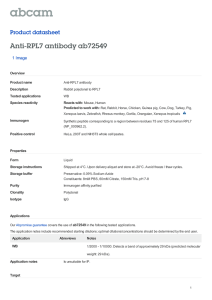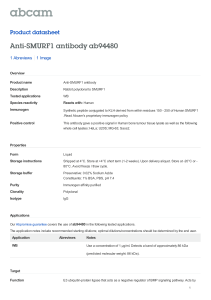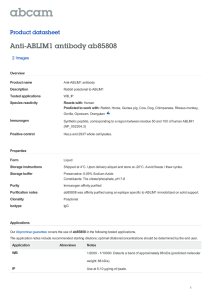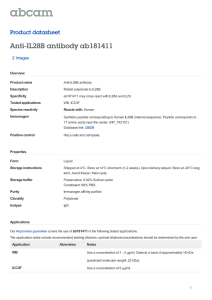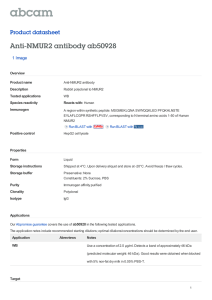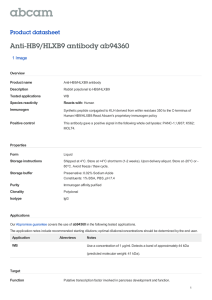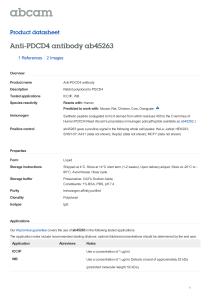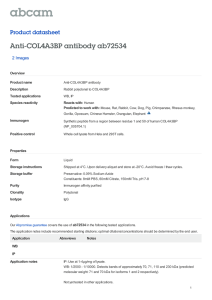Anti-DDB1 with anti-GAPDH internal loading control antibody ab75393
advertisement
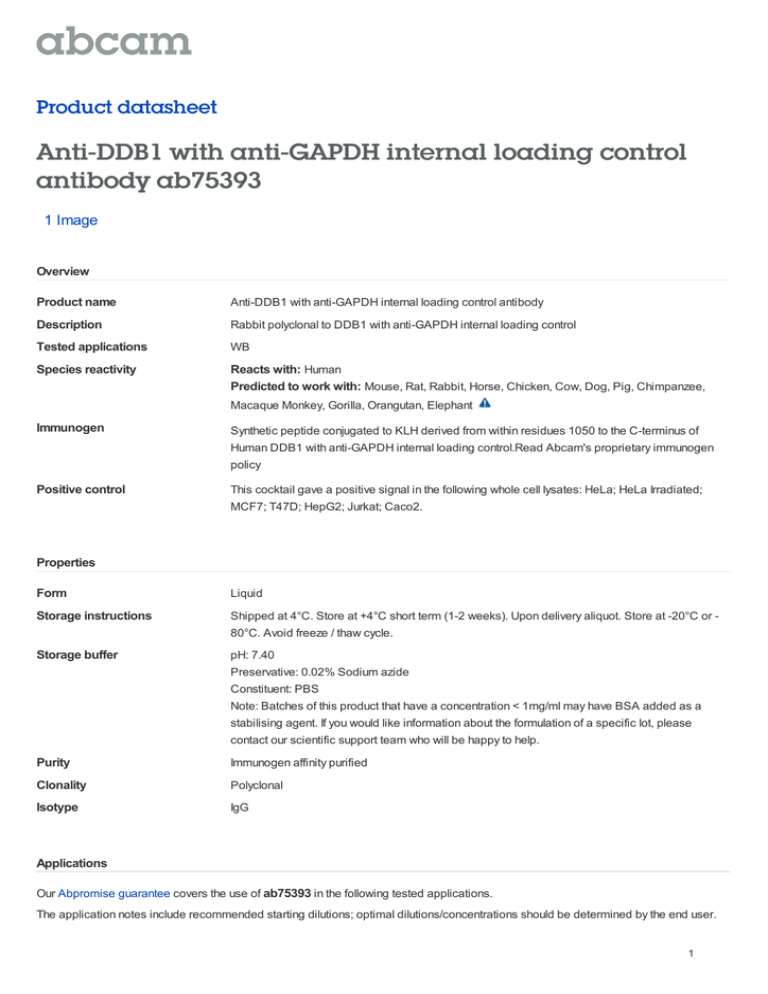
Product datasheet Anti-DDB1 with anti-GAPDH internal loading control antibody ab75393 1 Image Overview Product name Anti-DDB1 with anti-GAPDH internal loading control antibody Description Rabbit polyclonal to DDB1 with anti-GAPDH internal loading control Tested applications WB Species reactivity Reacts with: Human Predicted to work with: Mouse, Rat, Rabbit, Horse, Chicken, Cow, Dog, Pig, Chimpanzee, Macaque Monkey, Gorilla, Orangutan, Elephant Immunogen Synthetic peptide conjugated to KLH derived from within residues 1050 to the C-terminus of Human DDB1 with anti-GAPDH internal loading control.Read Abcam's proprietary immunogen policy Positive control This cocktail gave a positive signal in the following whole cell lysates: HeLa; HeLa Irradiated; MCF7; T47D; HepG2; Jurkat; Caco2. Properties Form Liquid Storage instructions Shipped at 4°C. Store at +4°C short term (1-2 weeks). Upon delivery aliquot. Store at -20°C or 80°C. Avoid freeze / thaw cycle. Storage buffer pH: 7.40 Preservative: 0.02% Sodium azide Constituent: PBS Note: Batches of this product that have a concentration < 1mg/ml may have BSA added as a stabilising agent. If you would like information about the formulation of a specific lot, please contact our scientific support team who will be happy to help. Purity Immunogen affinity purified Clonality Polyclonal Isotype IgG Applications Our Abpromise guarantee covers the use of ab75393 in the following tested applications. The application notes include recommended starting dilutions; optimal dilutions/concentrations should be determined by the end user. 1 Application WB Abreviews Notes Use a concentration of 1 µg/ml. Detects a band of approximately 37, 127 kDa (predicted molecular weight: 37, 127 kDa). ab75393 contains 2 antibodies, generated by raising against an DDB1 immunogen and spiking with anti-GAPDH loading control. Application notes Is unsuitable for ChIP,Flow Cyt,ICC or IHC-P. Target Function Required for DNA repair. Binds to DDB2 to form the UV-damaged DNA-binding protein complex (the UV-DDB complex). The UV-DDB complex may recognize UV-induced DNA damage and recruit proteins of the nucleotide excision repair pathway (the NER pathway) to initiate DNA repair. The UV-DDB complex preferentially binds to cyclobutane pyrimidine dimers (CPD), 6-4 photoproducts (6-4 PP), apurinic sites and short mismatches. Also appears to function as a component of numerous distinct DCX (DDB1-CUL4-X-box) E3 ubiquitin-protein ligase complexes which mediate the ubiquitination and subsequent proteasomal degradation of target proteins. The functional specificity of the DCX E3 ubiquitin-protein ligase complex is determined by the variable substrate recognition component recruited by DDB1. DCX(DDB2) (also known as DDB1-CUL4-ROC1, CUL4-DDB-ROC1 and CUL4-DDB-RBX1) may ubiquitinate histone H2A, histone H3 and histone H4 at sites of UV-induced DNA damage. The ubiquitination of histones may facilitate their removal from the nucleosome and promote subsequent DNA repair. DCX(DDB2) also ubiquitinates XPC, which may enhance DNA-binding by XPC and promote NER. DCX(DTL) plays a role in PCNA-dependent polyubiquitination of CDT1 and MDM2-dependent ubiquitination of TP53 in response to radiation-induced DNA damage and during DNA replication. DCX(ERCC8) (the CSA complex) plays a role in transcription-coupled repair (TCR). May also play a role in ubiquitination of CDKN1B/p27kip when associated with CUL4 and SKP2. Pathway Protein modification; protein ubiquitination. Sequence similarities Belongs to the DDB1 family. Post-translational modifications Phosphorylated by ABL1. Ubiquitinated by CUL4A. Subsequently degraded by ubiquitin-dependent proteolysis. Cellular localization Cytoplasm. Nucleus. Primarily cytoplasmic. Translocates to the nucleus following UV irradiation and subsequently accumulates at sites of DNA damage. Anti-DDB1 with anti-GAPDH internal loading control antibody images 2 All lanes : Anti-DDB1 with anti-GAPDH internal loading control antibody (ab75393) at 1 µg/ml Lane 1 : HeLa (Human epithelial carcinoma cell line) Whole Cell Lysate Lane 2 : Hela Whole Cell Lysate - UV Irradiated Lane 3 : MCF7 (Human breast adenocarcinoma cell line) Whole Cell Lysate Lane 4 : T47D (Human ductal breast Western blot - Anti-DDB1 with internal loading epithelial tumor cell line) Whole Cell Lysate control antibody (ab75393) (ab14899) Lane 5 : HepG2 (Human hepatocellular liver carcinoma cell line) Whole Cell Lysate Lane 6 : Jurkat (Human T cell lymphoblastlike cell line) Whole Cell Lysate Lane 7 : Caco 2 (Human colonic carcinoma cell line) Whole Cell Lysate Lysates/proteins at 10 µg per lane. Secondary Goat Anti-Rabbit IgG H&L (HRP) preadsorbed (ab97080) at 1/5000 dilution developed using the ECL technique Performed under reducing conditions. Predicted band size : 37, 127 kDa Observed band size : 37,127 kDa Additional bands at : 32 kDa,60 kDa. We are unsure as to the identity of these extra bands. Exposure time : 30 seconds Please note: All products are "FOR RESEARCH USE ONLY AND ARE NOT INTENDED FOR DIAGNOSTIC OR THERAPEUTIC USE" Our Abpromise to you: Quality guaranteed and expert technical support Replacement or refund for products not performing as stated on the datasheet Valid for 12 months from date of delivery Response to your inquiry within 24 hours We provide support in Chinese, English, French, German, Japanese and Spanish Extensive multi-media technical resources to help you We investigate all quality concerns to ensure our products perform to the highest standards 3 If the product does not perform as described on this datasheet, we will offer a refund or replacement. For full details of the Abpromise, please visit http://www.abcam.com/abpromise or contact our technical team. Terms and conditions Guarantee only valid for products bought direct from Abcam or one of our authorized distributors 4
